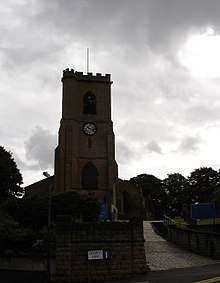Church of St Mary the Virgin and All Souls, Bulwell
| St Mary the Virgin and All Souls, Bulwell | |
|---|---|
 St Mary the Virgin and All Souls, Bulwell | |
 St Mary the Virgin and All Souls, Bulwell Location within Nottinghamshire | |
| 53°00′00″N 1°11′39″W / 52.999932°N 1.194034°WCoordinates: 53°00′00″N 1°11′39″W / 52.999932°N 1.194034°W | |
| Location | Bulwell, Nottinghamshire |
| Country | England |
| Denomination | Church of England |
| Churchmanship | High Church |
| History | |
| Dedication | St Mary the Virgin and All Souls |
| Architecture | |
| Heritage designation | Grade II listed[1] |
| Specifications | |
| Length | 126 feet 2 inches (38.46 m) |
| Width | 54 feet 6 inches (16.61 m) |
| Bells | 8 |
| Administration | |
| Parish | Bulwell[2] |
| Deanery | Nottingham North |
| Archdeaconry | Nottingham |
| Diocese | Southwell and Nottingham |
| Province | York |
| Clergy | |
| Vicar(s) | Fr. Andrew Fisher |
The Church of St Mary the Virgin and All Souls, Bulwell is a parish church of the Church of England in Nottinghamshire, England.[3]
The church is Grade II listed by the Department for Culture, Media & Sport as it is a building of special architectural or historic interest.[1]
History
The church was built on the site of an earlier church, dating from possibly the 12th century. This church was badly damaged by a storm in 1843.
It was constructed between 1849 and 1850 and the architect was Henry Isaac Stevens. The church was consecrated on 4 November 1850 by the Right Revd. Dr. Kaye, Bishop of Lincoln.[4]The chancel was added in 1900 by William Arthur Heazell. The north chapel was added in 1946.
Organ
A new organ was opened in 1852 by George Cooper, the assistant organist of St Paul’s Cathedral.[5] The current pipe organ dates from 1872 by Forster and Andrews. In 1899 a new organ chamber was built to house the organ and move it from its location in the north transept.[6] A specification of the organ can be found on the National Pipe Organ Register.[7]
Bells
The tower contains eight bells all by John Taylor and Company of Loughborough dating from 1919/20 and 1860.[8]
Clock
The 90 year old clock was replaced by a new one by G. & F. Cope with an all electric mechanism in 1949.[9]
Sources
| Wikimedia Commons has media related to Category:St Mary's Church, Bulwell. |
- 1 2 Historic England. "Church of St Mary the Virgin and All Souls (1254584)". National Heritage List for England. Retrieved 5 January 2014.
- ↑ "St Mary the Virgin & All Souls, Bulwell". A Church Near You. The Church of England. Retrieved 24 July 2017.
- ↑ Pevsner, Nikolaus (1979). Nottinghamshire (Pevsner Architectural Guides: Buildings of England). Harmondsworth, Middx. Penguin. ISBN 978-0300096361.
- ↑ "Bulwell New Church". Nottingham Review and General Advertiser for the Midland Counties. England. 8 November 1850. Retrieved 24 July 2017 – via British Newspaper Archive. (Subscription required (help)).
- ↑ "Bulwell Church". Nottinghamshire Guardian. England. 3 June 1852. Retrieved 24 July 2017 – via British Newspaper Archive. (Subscription required (help)).
- ↑ "New organ chamber at Bulwell Church". Nottingham Evening Post. England. 21 June 1899. Retrieved 24 July 2017 – via British Newspaper Archive. (Subscription required (help)).
- ↑ "NPOR E01418". National Pipe Organ Register. British Institute of Organ Studies. Retrieved 24 July 2017.
- ↑ "Bulwell Nottingham, Notts S Mary V & All Souls". Dove's Guide for Church Bell Ringers. Dovemaster. 14 July 2017. Retrieved 24 July 2017.
- ↑ "Bulwell Church Clock. Lighting on June 15th". Nottingham Evening Post. England. 12 May 1949. Retrieved 24 July 2017 – via British Newspaper Archive. (Subscription required (help)).